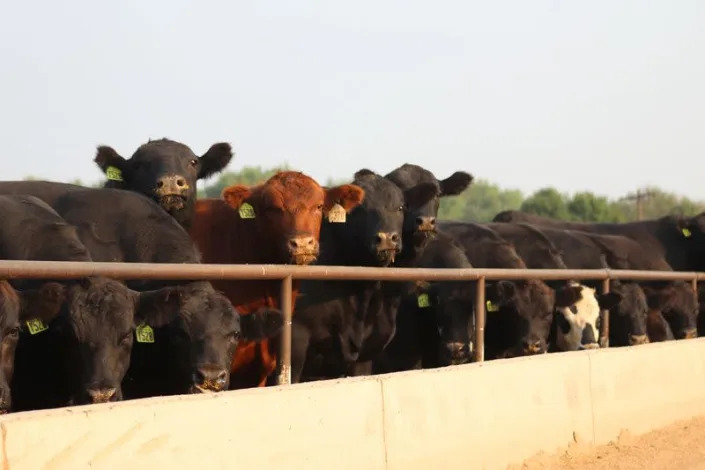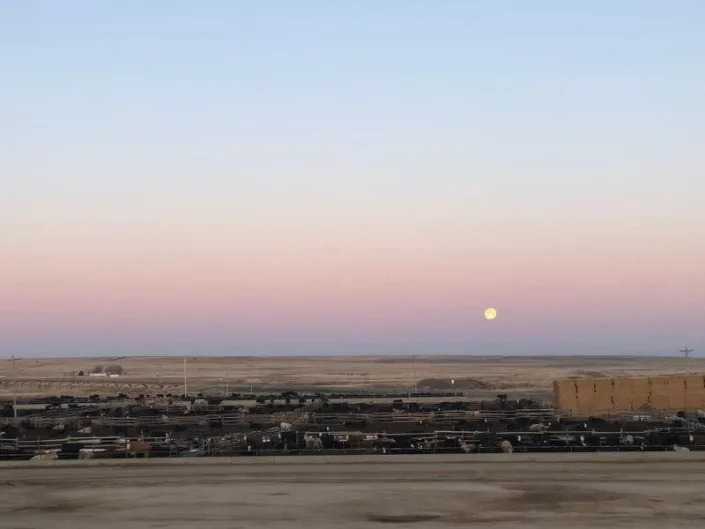Thousands of U.S. cattle buried dumped Landfill
1 / 5
Exclusive: Thousands of U.S. cattle buried, dumped at Kansas landfill after deadly heatwave -documents
Five Rivers Cattle Feeding, in Ulysses, Kansas
Tom Polansek
Tue, July 26, 2022 at 6:06 AM·4 min read
By Tom Polansek
CHICAGO (Reuters) - Top U.S. cattle feeding companies sent 1,000-pound carcasses to a Kansas landfill, where they were flattened by loader machines and mixed with trash, after a June heatwave killed thousands of cows, documents seen by Reuters show.
Other cattle were buried in unlined graves, a feeding company said.
Neither is a typical method for disposing of bodies. But so many cows died in the unusual heat and humidity that facilities that normally convert carcasses into pet food and fertilizer products were overwhelmed, prompting the state government and cattle feeders to take emergency measures.
The mass deaths and subsequent scramble to deal with decaying bodies sparked a push for changes in the meat industry in Kansas, the third-largest U.S. cattle state.
Kansas is forecast to see more high temperatures that can stress and potentially kill cattle this summer, adding to the myriad problems caused by increasingly extreme weather linked to climate change.
Although state officials authorized companies to dispose of carcasses at the Seward County Landfill in Liberal, Kansas, they are now considering alternatives to decrease the risks for foul smells and other problems if more deaths occur, the landfill's director said.
The disposal methods and identities of companies that lost cattle have not previously been reported. They were contained in documents Reuters obtained from the Kansas Department of Health and Environment and confirmed by some companies involved.
At least 2,117 cattle died after humidity levels spiked, winds disappeared and temperatures topped 100 degrees Fahrenheit (38°C) in southwestern Kansas during the weekend of June 11, state records show. It was early in the year for such heat and before some cattle had fully shed their winter coats.
Seward County Landfill Director Brock Theiner estimated the dump alone took in roughly 1,850 to 2,000 dead cattle.
FLATTENED CATTLE, PUTRID SMELL
Landfill workers used loading equipment with steel wheels to flatten the cattle to about eight inches and mixed the bodies with garbage, a process that took nearly three weeks, Theiner said.
"After you run them over they'll go flat, but they're gonna sponge back up," Theiner said. "You get a mass of 'em and you get on it, and it's like running a piece of equipment on top of a water bed. It moves."
Kansas temporarily suspended requirements that carcasses be covered by at least six inches (15.24 cm) of dirt or trash each day due to the unexpected deaths, Theiner said. The carcasses had a putrid smell up close, he added.
"Once you got in it, whew!" he said. "I have a couple operators that have iron guts."
Landfills are the last resort for carcasses because of complications with smells, animals digging in trash, and difficulties covering the bodies immediately, Theiner said. Kansas officials are exploring whether more cattle could be composted at feedlots instead, he said.
The Kansas Department of Health and Environment did not respond to questions.
Cactus Feeders, which says it handles 4% of U.S. fed cattle, sent carcasses to the dump, as did Cobalt Cattle, Meade County Feeders and Irsik & Doll's Sunbelt Feed Yard, department records show. The companies, which fatten cows on grain before slaughter, had no comment.
Grant County Feeders in Ulysses, Kansas, shipped carcasses to the landfill because rendering plants were full, said Tom McDonald, an executive with owner Five Rivers Cattle Feeding - the world's largest such company which counts meatpacker JBS SA among its customers.
Cows that die of heat stress are not processed into meat for human consumption but can normally be converted into animal food, fertilizer and other products.
Moving forward, Five Rivers will feed cattle less grain, a high-energy ingredient, and more hay and silage when temperatures rise to minimize their internal heat, McDonald said. The company is not considering other steps like adding shade, he said, because the mass deaths were rare.
Cattle Empire, a feedyard in Satanta, Kansas that supplies Tyson Foods, put carcasses in landfills and buried others in unlined pits with the mineral lime to break down the bodies faster, veterinarian Tera Barnhardt said.
Burying cattle in unlined pits is one of the riskiest disposal methods because waste can seep into groundwater, said Hannah Connor, senior attorney for the Center for Biological Diversity.
Kansas allows unlined burials near Cattle Empire because the groundwater is deep down, Barnhardt said.
All told, at least 617 cattle were buried by Cattle Empire, Friona Industries, NextGen Cattle and Clark County Feeders, state documents show.
Hot, humid air gave the animals the feeling they were suffocating, Barnhardt said.
For cattle that survived, some are eating in unusual patterns that can diminish their ability to gain weight, veterinarians said.
"Cattle are somewhat still struggling," Barnhardt said. "We really compromised them."




Comments
Food crisis will be for reals, y'alls. Look forward to $20.00 single patty burgers from McD's soon.
Dem croakers get ripe darned quick in the heat. I can just imagine the stink of "Landfill workers used loading equipment with steel wheels to flatten the cattle to about eight inches" was quite nauseating.
I find that story hard to believe for the simple reason those feed lots have been in business for many years and it's always hot in Kansas in June, why would this year be any different than any other year
Seen/heard a rumor that when Covid hit China and lots of people being masss buried the Chinease found that crops growed lot faster and better over the burial sites. (made good fertilizer)
I was wondering if they were referring to the China rice they were sending to the USA??????(that I see in Wal-Mart)
Noticed some of the Wal-Mart rice is Brown instead of white?????????Might want to take a sniff of that when the seal is broken on the plastic bag.
I don't eat rice.
I agree. Sounds more like sabatoge to me. Been hot forever, and hotter than that before. Sounds mighty fishy.
Why is this a story? Apart from the smell that the landfill guys suffer..........this stuff will decay and morph into soil alot quicker than all of the plastic and metal buried around them.
@Okie743 "I don't eat rice."
yeah, that's pretty obvious...
Just another way to starve us into submission..
I'll say as a former cattle and dairy farmer, this is one of the reasons why I think farms are better place for cattle than packing them in tight to a shade less, unsanitary feed lot. I realize that industrial farming is profitable largely due to economy of scale. I guess that is why they are still in the business, and we found other things to do for free. 😉
The closer proximity more animals are to each other, the higher the risk for wide spread contamination. With no place for them to escape the heat, I guess this can happen. It does get hot in Kansas, hotter than 100. But, the article said they hadn't lost their winter coat. I don't think I believe that as ours seemed to by end of April first part of May.
Don't know about the cattle but I have seen this happen frequently with chickens and hogs . I raised broilers commercially for 30 years . One summer a heat wave killed 15,000 birds that were just shy of a week away from market on my farm . Not an uncommon occurrence in north carolina.
Sweltering heat and draught combined with Biden in the Whitehouse: We are in deep DooDoo.
That could be a good thing, simce they wanna do away with nitrogen fertilizer. Gonna need a LOT of doodoo to get crops to grow. FJB
I didn't think about using them for fertilizer. But 600 cows through a wood chipper won't be enough for them industrial farms.
Most feedlots have both shade and sprinklers to help offset the effects of heat. Several factors could create a serious problem. Maybe the sprinklers failed? Maybe the wind didn't blow? Maybe there was an undiagnosed lung infection that suddenly showed up at the same time one of the environmental factors kicked in.
Folks, feedlots are in the business of growing cattle/adding weight(fat) in an efficient and profitable manner. Keeping livestock healthy and eating is the way that happens. Overheated, thirsty animals are NOT eating. Sick animals are NOT eating. Animals can't talk so the penriders must interpret the mannerisms of the livestock and make decisions as to their well being. An inexperienced penrider failing to make good decisions could start a spiral of disease that could end with a LOT of sick cattle that end up dying because extreme heat exacerbated their respiratory distress.
OH BTW, you can't just 'grind up' cattle and use them for fertilizer. Where do you think all the bone splinters would go??????????????????
Oh by the way.....
I meant use all the "deep doodoo" that we are in for fertilizer!
Taco bell comes to mind
For some reason
Have you ever traveled through Kansas and seen those big mountains of cow manure right beside the Hi-way and the smell would gag a buzzard. I never did see a buzzard. Seen lots of feeder cattle right beside the road standing almost knee deep in muck/manure eating from concrete troughs in penned lots.
AND the Democrats (Donkey Pox people) complain about the sight of salvages that can be seen from the Hi-Ways and make them put up a solid fence so as it does not distract from the estatic beauty of the area.
Hard to believe though that 1000's of cattle dying because of heat realated in Kansas.
Might be some of that FAKE news the Democrats like to spread.
I suspect there was foul play involved. Just another way to starve the popluation into submission.
Gonna get worse very soon.